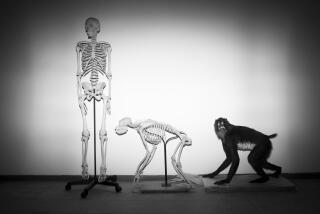Skeleton Yields Clues About Ability to Grasp
Of all the things that distinguish humans and other primates -- thumbs, the ability to leap and forward-facing eyes -- it was the ability to grasp that evolved first, researchers reported in this week’s issue of Science.
A 56-million-year-old skeleton found in Wyoming shows that one of the earliest primate ancestors had an opposable big toe, allowing it to creep to the outermost branches of trees for nuts and fruit.
It also probably kept a sharp eye out to avoid becoming someone else’s meal. “Now we know that grasping evolved before eyes facing forward ... and before leaping,” said anthropologist Eric Sargis of Yale University.
The bones of the animal, Carpolestes simpsoni, were preserved in a limestone block. Unusual for such an old fossil, the tiny foot bones were almost intact.




